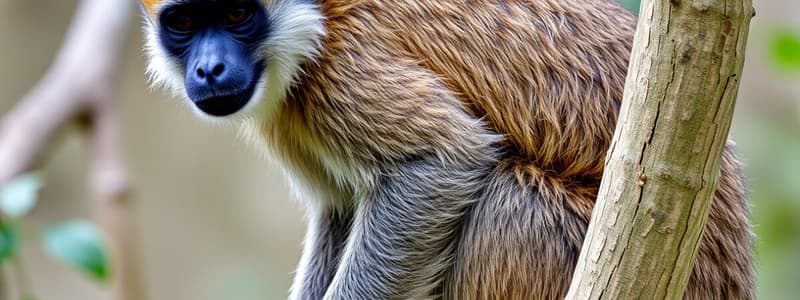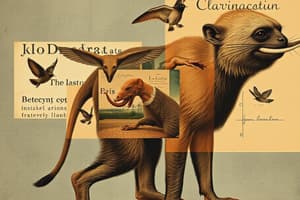Podcast
Questions and Answers
What are common names used to describe?
What are common names used to describe?
- Types of furniture
- Types of vehicles
- Types of dogs (correct)
- Types of technology
What is the formal name of an organism that is always written in italics?
What is the formal name of an organism that is always written in italics?
Scientific name
Who invented the system of classification we use today?
Who invented the system of classification we use today?
Linnaeus
What is a two-part naming system called?
What is a two-part naming system called?
What is a level of Linnaeus' naming system of classification?
What is a level of Linnaeus' naming system of classification?
What is the science of classification and nomenclature?
What is the science of classification and nomenclature?
What classification system indicates evolutionary relationships among organisms?
What classification system indicates evolutionary relationships among organisms?
What are traits shared among organisms due to common adaptation, but not recent common ancestry called?
What are traits shared among organisms due to common adaptation, but not recent common ancestry called?
What are traits shared by organisms because they have a recent common ancestor called?
What are traits shared by organisms because they have a recent common ancestor called?
What form of classification is based on evolutionary lineages and focuses on shared derived traits?
What form of classification is based on evolutionary lineages and focuses on shared derived traits?
What is a form of classification that considers evolutionary lineage but also changes along a lineage?
What is a form of classification that considers evolutionary lineage but also changes along a lineage?
What traits classify mammals?
What traits classify mammals?
How is a species defined?
How is a species defined?
What are the anatomical traits that define a certain type of mammal called?
What are the anatomical traits that define a certain type of mammal called?
What is the ability to flex and grasp with fingers called?
What is the ability to flex and grasp with fingers called?
What do prosimians have that is a thin bony enclosure of the eye orbit?
What do prosimians have that is a thin bony enclosure of the eye orbit?
What are primates that live and move in the trees called?
What are primates that live and move in the trees called?
What is the group that includes lemurs, lorises, and tarsiers called?
What is the group that includes lemurs, lorises, and tarsiers called?
What is the name of the group that includes monkeys, apes, and humans?
What is the name of the group that includes monkeys, apes, and humans?
What is a longer snout with whiskers and a wet nose that is found in lemurs and lorises called?
What is a longer snout with whiskers and a wet nose that is found in lemurs and lorises called?
What type of claw is found in lemurs on the second digit of the foot?
What type of claw is found in lemurs on the second digit of the foot?
What looks like a small hair comb attached to the mandible in prosimians?
What looks like a small hair comb attached to the mandible in prosimians?
What type of primate can fit into both the Prosimian and Anthropoidea classifications?
What type of primate can fit into both the Prosimian and Anthropoidea classifications?
What traits do monkeys, apes, and humans share?
What traits do monkeys, apes, and humans share?
What term describes activities done during daylight?
What term describes activities done during daylight?
What term describes activities done during nighttime?
What term describes activities done during nighttime?
What are the monkeys with sideways facing nostrils called?
What are the monkeys with sideways facing nostrils called?
A tail that can grasp is called a ______.
A tail that can grasp is called a ______.
Flashcards are hidden until you start studying
Study Notes
Classification Terminology
- Common names are familiar terms used for various types of animals and plants.
- Scientific names are formal names of organisms, always written in italics for distinction.
- Linnaeus developed the modern system of biological classification, which is foundational in taxonomy.
- Binomial nomenclature is a two-part naming system that gives each species a unique identifier.
Taxonomy and Classification Systems
- Taxon refers to any level in Linnaeus' classification hierarchy.
- Taxonomy is the science encompassing the categorization and naming of living organisms.
- Phylogeny indicates the evolutionary relationships among different organisms.
Character Traits in Classification
- Analogous characters are traits shared due to common adaptations, not recent ancestry.
- Homologous characters are traits derived from a recent common ancestor, passed down through generations.
Methods of Taxonomic Classification
- Cladistic Taxonomic Classification relies on evolutionary lineages and shared derived traits, focusing primarily on branching events in evolution.
- Evolutionary Taxonomic Classification also considers evolutionary relationships and the changes that occur along lineages (anagenetic evolution).
Mammalian and Primate Traits
- Mammalian traits include hair, warm-bloodedness, lactation, a four-chambered heart, and diphyodont dentition (two sets of teeth).
- Primate traits involve five digits on hands and feet, opposable thumbs, nails instead of claws, and a larger brain-to-body mass ratio compared to other mammals.
Distinct Primate Features
- Prehensility is the ability to grasp with fingers, essential for primate adaptation.
- The postorbital bar is a bony structure around the eye orbit, present in prosimians.
- Arboreal primates are species that primarily live and navigate in trees.
Primate Groups
- Prosimian (Prosimii) includes lemurs, lorises, and tarsiers, characterized by triangular molars and large eye orbits for nocturnal activity.
- Anthropoids (Anthropoidea) comprise monkeys, apes, and humans, sharing similarities in traits like larger brain size and reduced olfactory capabilities.
Additional Distinctive Traits
- Rhinarium is a moist, elongated nose found in lemurs and lorises, enhancing their sense of smell.
- Grooming claws are unique to lemurs and are present on the second digit of the foot, used for personal care.
- The tooth comb, an elongation of lower incisors and canines, is utilized by prosimians for grooming.
Ecological Behavior
- Tarsiers can be classified under both Prosimian and Anthropoid distinctions due to unique traits like their large eyes.
- Diurnal signifies activities performed during daylight hours, while nocturnal refers to activities that occur at night.
- New World Monkeys, or Platyrrhines, exhibit sideways-facing nostrils and primarily inhabit Mexico and South America.
Unique Adaptations
- New World Monkeys possess prehensile tails, aiding in their arboreal lifestyle, enabling them to grasp branches while moving through trees.
Studying That Suits You
Use AI to generate personalized quizzes and flashcards to suit your learning preferences.




